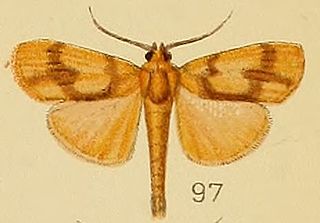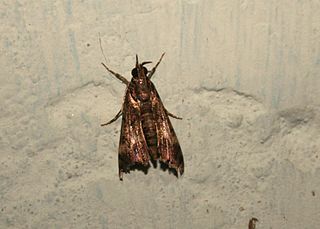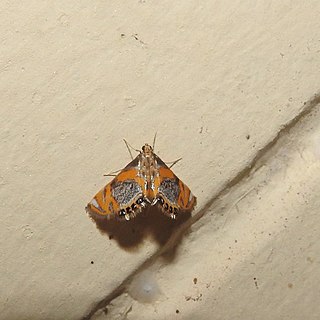
Ulopeza is a genus of moths of the family Crambidae. It was described by Philipp Christoph Zeller in 1852.

Noorda is a genus of moths of the family Crambidae, and the only genus in the subfamily Noordinae.

Synclera is a genus of moths of the family Crambidae described by Julius Lederer in 1863.

Sufetula is a genus of moths of the family Crambidae.

Glyphodes negatalis, the karanj defoliator, is a moth of the family Crambidae. The species was first described by Francis Walker in 1859. It has a wide range in the tropics, including South Africa, The Gambia, Mali, India, Sri Lanka, Hong Kong, Japan, and eastern Australia.

Bradina admixtalis is a species of moth of the family Crambidae described by Francis Walker in 1859. It is found in Australia, New Guinea, New Zealand, south-east Asia and the Comoros, Réunion, South Africa as well as India.

Orphanostigma abruptalis is a moth of the family Crambidae. The species was first described by Francis Walker in 1859. It occurs in the tropics of the Old World from Africa to Australia.

Nymphicula blandialis is a moth in the family Crambidae. It was described by Francis Walker in 1859. It is found in southern China, India, Malaysia, Sri Lanka, Taiwan, Japan, the Democratic Republic of the Congo, Ghana, Guinea, Mozambique, Nigeria, South Africa and Uganda.
Circobotys sinisalis is a moth in the family Crambidae. It was described by Francis Walker in 1859. It is found in the Democratic Republic of the Congo, Kenya and South Africa, where it has been recorded from the Eastern Cape.
Palpita elealis is a moth in the family Crambidae. It was described by Francis Walker in 1859. It is found in Cameroon, the Republic of the Congo, the Democratic Republic of the Congo, Ghana, Ivory Coast, Sierra Leone, South Africa, São Tomé and Príncipe, the Gambia, Zambia and Zimbabwe.

Pagyda salvalis is a moth in the family Crambidae. It was described by Francis Walker in 1859. It is found in South Africa, Zimbabwe and Sri Lanka.
Mecyna procillusalis is a moth in the family Crambidae. It was described by Francis Walker in 1859. It is found in South Africa.
Antigastra morysalis is a moth in the family Crambidae. It was described by Francis Walker in 1859. It is found in South Africa.
Ghesquierellana hirtusalis is a moth in the family Crambidae. It was described by Francis Walker in 1859. It is found on the Comoros (Mohéli) and in the Democratic Republic of the Congo, Ethiopia, Réunion, Madagascar, Sierra Leone, South Africa, Zimbabwe, and Mali.

Glyphodes pyloalis, the lesser mulberry snout moth, lesser mulberry pyralid or beautiful glyphodes moth, is a moth in the family Crambidae. It was described by Francis Walker in 1859. It is found in Iran, China, Japan, India, Indonesia (Sumatra), Sri Lanka, Taiwan, the Democratic Republic of the Congo, Equatorial Guinea, Mozambique and North America, where it has been recorded from Florida, Maryland, North Carolina, South Carolina and Virginia.
Lamprosema niphealis is a moth in the family Crambidae. It was described by Francis Walker in 1859. It is found in Africa.
Herpetogramma stultalis is a species of moth in the family Crambidae. It was described by Francis Walker in 1859. It is found in Malaysia, India, Sri Lanka, China, Japan, Pakistan, Papua New Guinea and Australia, where it has been recorded from Queensland. In Africa, it has been recorded from the Democratic Republic of the Congo and Réunion.

Notarcha obrinusalis is a species of moth in the family Crambidae. It was described by Francis Walker in 1859. It is found in Democratic Republic of the Congo, Zambia, China, India and Indonesia.
Omiodes poeonalis is a moth in the family Crambidae. It was described by Francis Walker in 1859. It is found in the Democratic Republic of the Congo, Sierra Leone, Tanzania, the Chagos Archipelago, China, Indonesia, Sri Lanka, Japan and Australia (Queensland).
Patania mysisalis is a species of moth in the family Crambidae. It was described by Francis Walker in 1859. It is found in Madagascar, Sierra Leone and South Africa.











